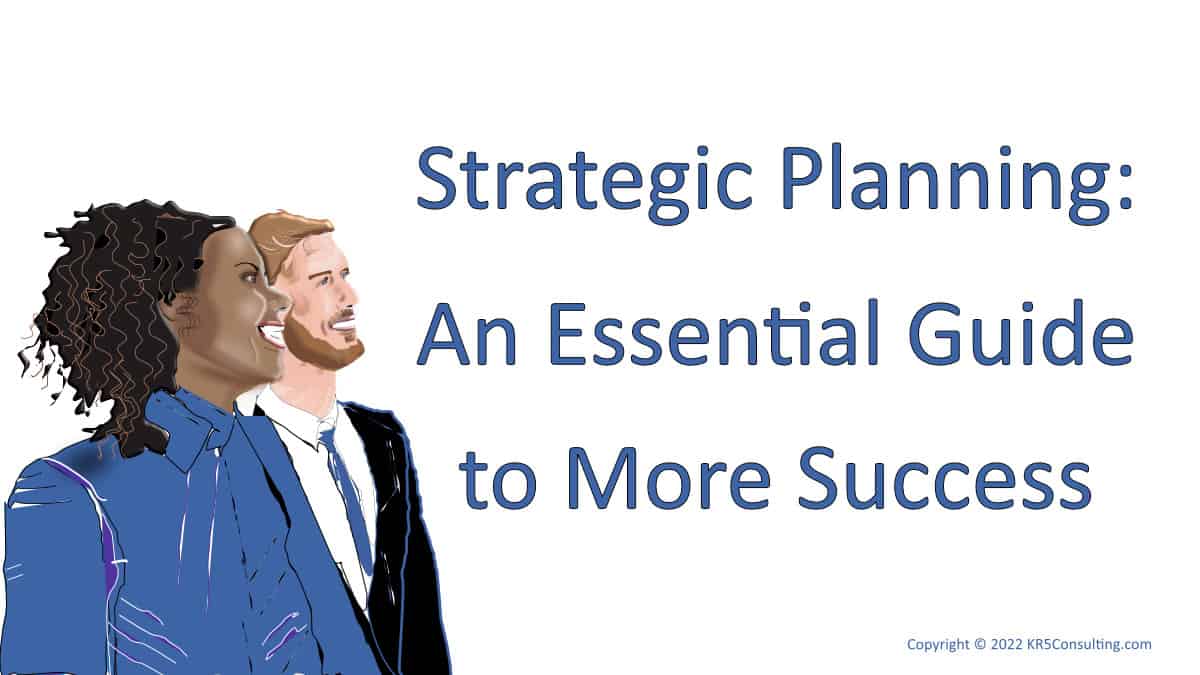Senior leaders use strategic planning to focus the business on changes that will result in a more successful long-term future. Long-term is three, five or even ten years depending on the business. Also, it helps the business to work smarter and work towards a bigger vision. As a result, you’re working towards a vision to make more of a difference.
But to their cost, entrepreneurs struggle with strategic planning. It can feel overwhelming to think about unknowns. To be sure, they can be put off by concerns that it would take too long or that it won’t deliver a good action plan.
This article explains why and how you use strategic planning to create long-term success. In addition, it covers the practical steps, and how you can turn that into an action plan. At the end of this, you’ll have more confidence to be bolder in making changes and use technology.
Table of contents
You might also be interested in our other in-depth guide, Business System: An Essential Guide to Growth. The Business System is “How” the business works to deliver results. The guide covers what it’s all about, why it’s important to business, and the steps involved.
The Strategic Planning Challenge
The idea of strategic planning can feel daunting. And you don’t want to waste time on something that sits on the shelf. But you do want the benefits of focus and successful positioning. Busy people don’t want a vague process: It must create clarity and lead to positive action.
In this part, we’ll cover what you’re looking to achieve, and why you’d want to spend time thinking about your business future. In Strategic Planning Steps, we’ll cover “how” you do it.
What is Strategic Planning in Business?
Strategic planning is a process that helps a business plan for a more successful future. It answers the question “where is the business going and how will it get there?”. The process involves weighing up what’s possible and choosing the best course of action.
Therefore, it gives you a vision and goals to drive long-term success. You don’t pluck them out the air, they’re the result of careful thinking. Challenging and realistic, they’re the best path for your business success.
But a vision and goals aren’t enough. Later in this article, in Turning Strategic Planning into Action, we’ll cover how you turn these goals into action. In other words, how you create the business changes that count.
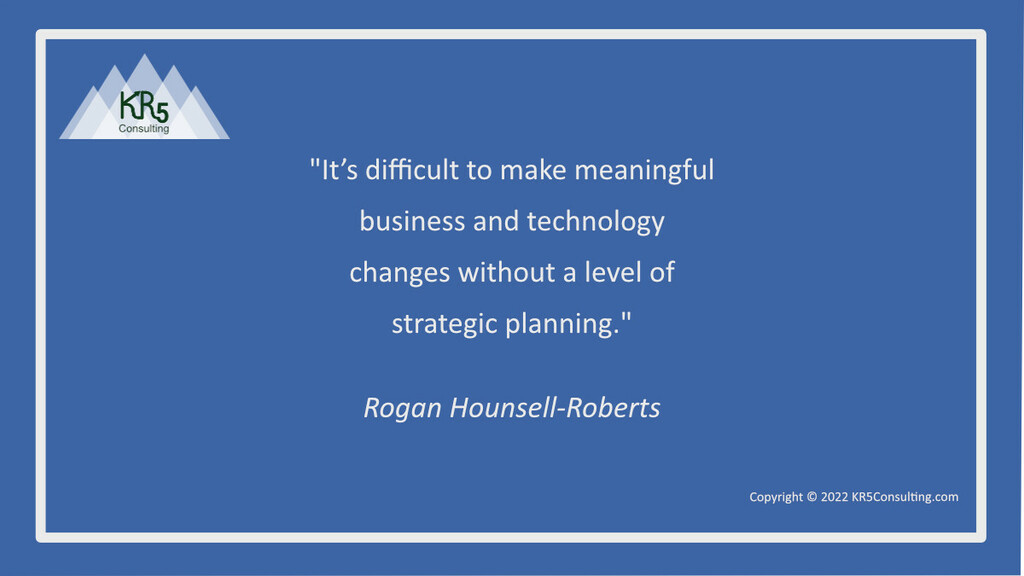
What is the Purpose of Strategic Planning?
The purpose of strategic planning is to achieve business growth. It sets a long-term direction for success over three, five or even ten years. And it helps a business to:
- create a stronger position in the market
- make effective change
- maximise its opportunities
You want to position the business for success. It’s not just about being in the right place at the right time. You also need to plan so that you have the resources and know how to achieve that success.
Consider a military unit that achieves a major success with a small force. It only works if they’re in the right place at the right time, have the training to know what to do, and the equipment to make it happen.
Therefore, it’s relevant to a business that wants to have the biggest impact using limited resource. It’s the power of the small unit. Strategic planning means you’ll be in the right place at the right time, prepared and focused on what counts. In other words, planning for success that helps the business leap forward.
You want to set-up the business for success. To create the set-up, you make business changes. For example, you might create or improve parts of the business. Without the big vision, it’s difficult to see where you need to make the changes that matter. It’s difficult to make meaningful business and technology changes without a level of strategic planning.
You might also be interested in Why digital transformation will make you succeed.
The Importance of Strategic Planning
Strategic planning is important to set the business on the right path. It will come as no surprise that businesses that plan their future are more successful than those that don’t. Creating a vision and setting goals keeps the business on track.
Planning filters down into how the business runs and how it needs to change. Change is necessary and takes time. Having a clear direction and goals puts the business on course to make successful changes.
Benefits of Strategic Planning
One of the biggest benefits of strategic planning is that it helps to improve thinking. It helps us think about the future, the choice of opportunities, and what we could achieve with what we’ve got. That’s hard to do when we’re thinking about the day-to-day problems in front of us.
Secondly it unites people in a common vision and plan. Through the process, leaders will know the choices and agree the direction. You’ll build support for a shared vision.
Thirdly you’ll have a programme for business change. The business will need to respond to the challenges. That will direct and guide changes to the business system and how technology can help.
Strategic Planning in a Smaller Business
It’s easy to see why a small business owner may think strategic planning is overkill. They might think that’s only for big business. Yet every business needs to plan for the future regardless of size. It’s different and less complex for a small business, but it’s the same process.
Strategic planning helps the leadership team to assess and plan the future. Small business leaders usually know what’s going on, but don’t find the time to assess. The process helps them organise their thoughts and decide what’s important. It helps them make decisions that will improve their prospects.
Building a plan for long-term success helps leaders to invest in the future. It’s easier to invest in a system change or use of technology when it’s part of a long-term plan.
You might also be interested in How much should SMEs invest in technology?
Strategic Planning Steps
The strategic planning steps involve answering the following questions:
- Where are you now?
- Where are you going?
- How will you get there?
This process helps leaders to make the best of opportunities. It’s not only about opportunities. It’s working out what you’ve got and what you need to overcome to make it successful. Your plan will then give you the best chance of success.
Where are you now?
Strategic planning starts with building a picture of how things are at the moment. Without a clear understanding of where you are, it’s difficult to plan a way forward. After all, you want to know about any obstacles so you can have a plan to overcome them. Equally, you don’t want to overlook anything that could help you succeed. It’s easy to overlook or brush aside things going on inside the business as it is outside. Naturally, failure to assess the true situation can make it harder for the business to move forward.
Therefore, you’ll need to look at both what’s going on in the business as well as what’s going on outside. As you don’t want to overlook anything important, you’ll look at the business from different viewpoints. So, you’ll want a view of your industry, your competitors as well as what’s internal to your business. But exactly how do you do that?
Strategic Planning Tools
Strategic planning tools help you build a complete picture of your business. First, we’ll look outside and inside the industry. Then you’ll review the business to see strengths and weaknesses. From this we create a summary of what’s most important using a SWOT (Strengths, Weaknesses, Opportunities, and Threats) analysis. So, let’s start.
What’s outside the industry (PESTLE)?
You can ask questions about how broader changes are affecting your industry and your business. This tool is a checklist to look at six different views (Cadle, Paul & Turner, 2010). It’s called PESTLE, an acronym for:
- Political such as changes to rules or policies that impact business.
- Economic such as growth, interest rates and market confidence.
- Socio–Cultural such as flexible working or normalising technology in everyday life.
- Technological such as advances or new uses.
- Legal such as changing regulations.
- Environmental such as moving to zero carbon.
You can frame questions for each of these views. For example, how are political changes affecting our:
- business?
- customers business?
- customers customer?
- supply chain?
You can brainstorm changes and impacts with your leadership team or business support group. Then circle the most important ones. Later, this will help you see what’s going on in your industry and find opportunities and threats.
For example, EU export rule changes increased paperwork, cost, and created delays. Exporters may look for more attractive markets, use automation to reduce cost, or develop new products to compete.
What’s going on inside the industry?
Entrepreneurs are good at finding gaps in the market, but how do you know if it’s the best one to go for? Looking for an underserved market is good, but how exactly do you find the most attractive one?
The answer is to segment the industry (Porter, 1985) based on differences in products and customer need. You can map competitors to segments and uncover gaps in the market. Not forgetting that a competitor could serve a segment but be too broad to do it well.
By looking at major product and customer differences you can segment an industry. For example, let’s look at the window industry. Obviously, there’s a different process for making uPVC versus wooden windows. Also, windows made for a listed building are different to windows for other homes. There is a variation in the needs of distinct types of customer too. For example, they may have a small or large budget. The needs for a customer building a block of flats will differ to a new house.
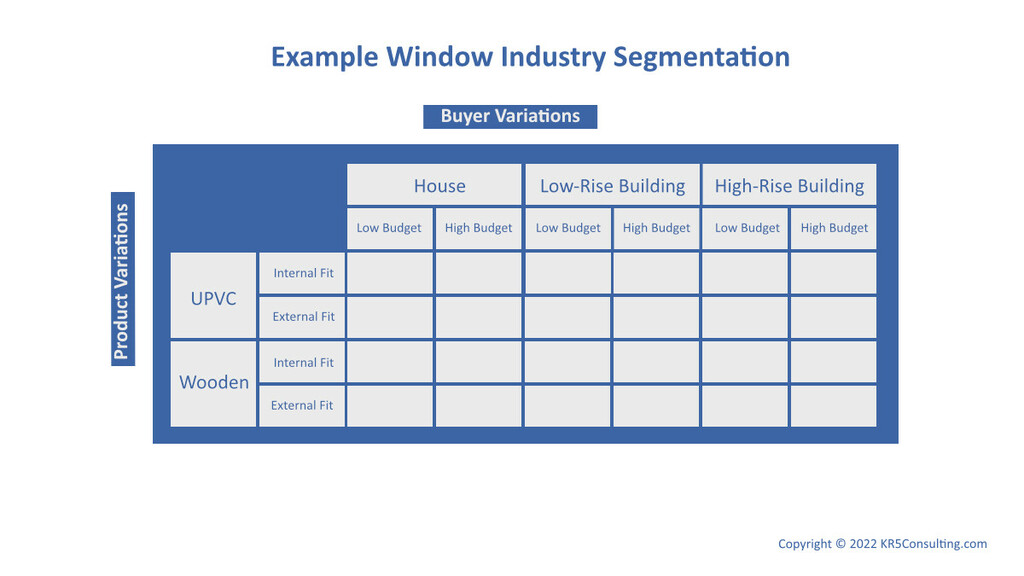
You can then consider where you want to compete. Industry segments may require certain ways of working and have different costs. And competitors will choose one or more industry segments to compete. Therefore, one of them could be more attractive than others. By creating a matrix based on major differences, you can compare the segments.
You can start to spot opportunities by looking at these segments. That’s to say there are buyers with unmet needs. Sometimes changes in technology mean that it’s possible to meet those needs. But there are also threats. Competitors in one segment may push into another.
Internal review
If you ask your leadership team to brainstorm strengths and weaknesses of the business, you may find its slow progress. It’s too abstract. You’ll make more progress by asking questions about specific areas. It’ll make it easier, and you’ll get better answers.
The following is also a checklist, but this one helps to review what’s going on inside the business (Cadle, Paul & Turner, 2010). Then you can see what’s strong, what’s weak and where you might want to improve.
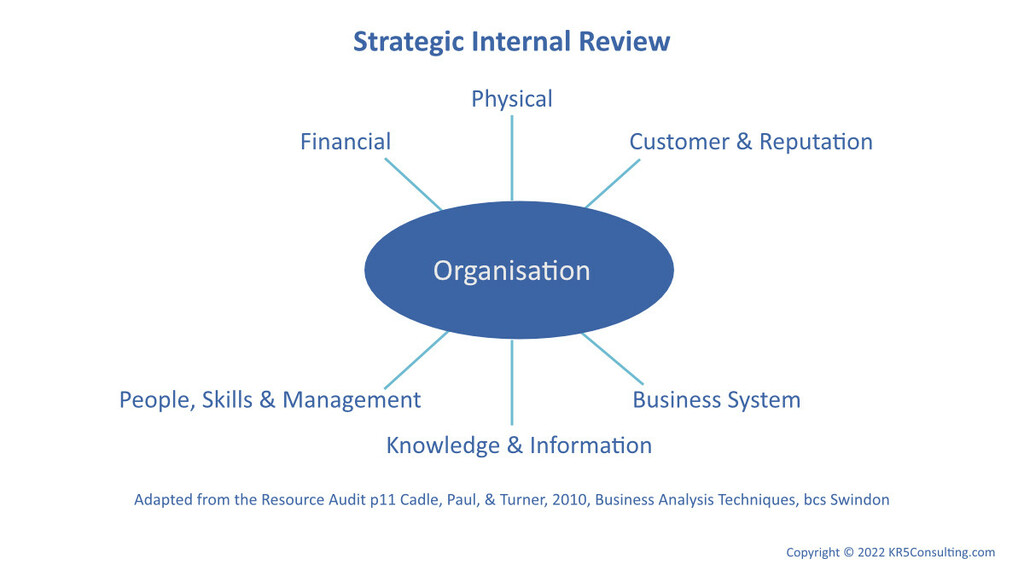
- Finances to fund business change through reserves or access to funding. Or is there a shortfall to funding?
- Physical assets such as offices, warehouses, and computer equipment to support growth. Or does a lack of assets limit growth?
- Customer feedback about the value you provide. What sort of reputation does the business have?
- People, skill, and management are the strengths and weaknesses of your human resources. Are staff motivated? Are managers able to develop individuals? Does the team work well together? Where are the gaps?
- Knowledge and information are all about the information held in the business. It could be a database of clients, market data, a method for producing something. It could also be a digital asset. Where is information lacking?
- The business system is how the business gets things done. Does it work well as a whole? What are its strengths? Where does it differentiate you from competitors? Where are the shortfalls?
Surprisingly, even in small businesses, there’s a gap in understanding about how the business system works. A clear overview of the business and how it creates value is a useful input for strategic planning. It’s a good place to uncover unique strengths and spot gaps.
Summarise key factors (SWOT)
It’s easier to make decisions for the future if you create a summary of the current situation. You want to draw out the key points and remove the noise. You do this using SWOT (Cadle, Paul & Turner, 2010) as follows:
- Strengths. What are the internal strengths of the business? Are there areas that could be stronger to help you compete?
- Weaknesses. What are the internal weaknesses where the business shouldn’t compete? Are there internal obstacles to success?
- Opportunities. What are the best industry segments for the business? That might include new products or markets.
- Threats. What are the possible competitor moves that would make a segment less attractive?
Using these key points, you can decide on the best direction for the business. It also helps you develop a strategy for success.
Where are you going?
Where do you want to be in three to five years, or even ten years? Now you’ve summarised the current situation, it’s time to decide where you’re going. Which opportunity will you choose? Then you’ll need to make more decisions about the detail.
If you’re an existing business, you’re likely to have a purpose and mission. These guide your choices. The purpose is why the business exists. The mission is what the business strives to do.
In this article, the vision is the end goal for the business in three, five or ten years. Your vision will align to your purpose and mission. It’s also worth revisiting your core values and principles. These are the guardrails for consistent decisions.
When you want to create an action plan, it helps to think of the vision as a big long-term goal. And you may find it helpful to break that up into smaller goals.
How will you get there?
How you’re going to get there is your business strategy. The strategy is how you plan to deliver the vision (or long-term goal). As you think about how you’ll get there, you’ll also set strategic goals. These are the measurable outcomes for your detailed plans.
Business Strategy
The strategy is how you plan to achieve the vision. It’s a series of decisions that shape the business system (or value chain). This is how you turn strategic planning into action. In other words, your goals shape your business so it will be successful.
It’s easier to build a strategy using a framework. Porter’s value chain (Porter, 1985) is what we’ll use here. You can then look at the various parts that create value in the business and make decisions. It’s like a checklist for creating a strategy. You won’t need every part for your business strategy, but you’ll know you’ve covered the bases.
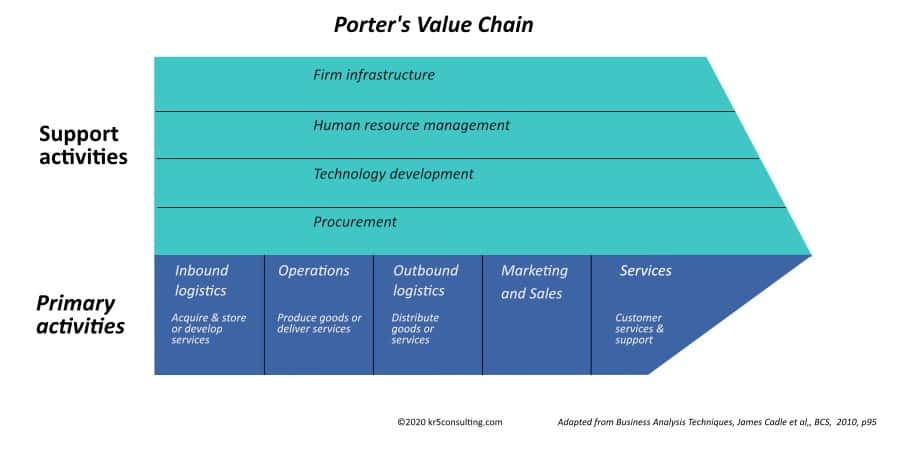
The strategy is the set of decisions that work together to give you the best chance of success. You may find conflicts between decisions. Each decision has pros and cons, and decisions may impact other decisions. Your aim is to find the best route through.
Let’s describe each of the parts to think about the decisions. They’re grouped into primary and supporting activities.
Primary Activities
The primary activities transform inputs into outputs as follows:
- Inbound logistics is about getting and storing the ingredients you use to produce something. You might decide to source locally or overseas. For knowledge, you might create an internal knowledge hub or use external training.
- Operations is about creating goods ready for delivery. Do you have a standard product you sell to a mass market, or is it bespoke? Is the way you create things unique?
- Outbound logistics is about how you deliver your product. You might deliver your product through a reseller. A services business might use a digital platform.
- Marketing and sales could be direct or through a channel. They could decide between digital or in person sales.
- Services is how customers get more value from what you produce after its delivered. You might decide to offer online or in person training. A manufacturer might decide to have their own service engineers or partner with another business to do that.
Supporting Activities
You need supporting activities to make your business run. Imagine if you had no technology, offices, or if people didn’t know what they needed to do. These aren’t as in your face as the primary ones yet could be sources of unique value. These are:
- Infrastructure covers the physical assets in the business. Having an office in the same area as your customer. Or a large warehouse so you can go for bigger deals.
- Human Resource management is about looking after and developing your staff. That’s about culture, and people giving their best too. You might have a learning culture that gives you a unique advantage.
- Technology development to reduce cost and solve problems. Are there ways you can improve the business? In what ways could technology change the game?
- Procurement is how you work with your suppliers. Working together to reduce friction and cost in the supply chain.
Working through these parts, make decisions on how you’ll use your strengths to achieve your long-term goal.
Strategic Goals
Your strategy is how you deliver your vision. Strategic goals are the milestones along the journey.
One way to uncover these goals is to work out what are the main things that will lead to success. These are also known as the Critical Success Factors (CSFs).
Strategic goals can’t be purely financial. The financials don’t get you to the destination, they tell you when you you’ve arrived. You need goals that help you get to your destination too.
The balanced scorecard (Kaplan and Norton 1996) helps you create your goals. It balances financial goals with the other goals needed for success.

Find your strategic goals or CSFs by looking at your strategy and finding what’s needed for success. Use the balance score card to create goals that balance what you need to do with the financial results you want to achieve. Create goals for your:
- Customer view of the business such as satisfaction, retention, and value for money
- Financial such as profit and cash flow
- Internal system such as use of technology, transformation, and improvement
- Innovation or learning and growth which is the people dimension.
Based on these, you can then define your key performance indicators.
Turning Strategic Planning into Action
How do you turn strategic planning into action? The goals are the challenges and obstacles to overcome. But what’s the best way to approach creating actions? And how do you reduce uncertainty?
How to approach creating actions
Creating an action plan from your strategic planning may feel a little overwhelming. It takes work, but it’s doable. Put simply it’s problem, solution, and delivery. However, before we get into that, there are three hurdles to overcome:
- Prioritisation, because you can’t do it all at once.
- Collaboration due to how it impacts people and that it must work for everyone.
- Making change manageable to avoid overwhelming people.
Priority and the business backlog
Obviously, you can’t do everything at once. You have to choose what you’ll do first. Anything else is counterproductive.
First you need to create a business change backlog. A backlog is simply a prioritised list of changes. But a backlog doesn’t start off as a prioritised list.
You can prioritise the backlog based on how important it is, and the amount of work involved. How important it is, could be because it’s needed for long-term success. On the other hand, it might be something needed for the day-to-day running of the business right now. For the amount of work, to start with you might give it a T-shirt size. It could be small, medium, or large, or even extra-large. Of course, you’ll need to think about what each size means for your business so it’s consistent.
When it comes to managing your backlog, you could favour quick wins first. However, in practise you must balance the small, medium, and large changes. You’ll also need to balance short and long-term changes.
Once you’ve got your backlog sorted, you can start to work through it.
Improving collaboration
Getting the people affected by change involved is a key to success (Kotter, 1996/2012). Changes that come out of strategic planning could have far reaching impacts. Those changes might affect how work’s done, or how it’s organised.
Get everyone involved from the start so they can help shape the solution. Make it clear why you’re making the change and why it’s urgent. For changes that cut across the business, be careful not to shoehorn it into a department. It’s better to have a change team that knows the big picture and not tied to a specific area of the business.
Making business change manageable
You don’t want your business to slow down because it’s trying to change too fast. You need to know the cost of change to the organisation before you start. If it’s too big, you’ll need to break it into smaller stages.
Knowing the impact and time scales of change requires preparation. However, you’ll get faster progress in the end. There’s always the unexpected, but if you can plan for all the other stuff, change will go more smoothly.
Be clear about what action you need to take
You make actions clear by defining the problem, describing what success looks like, and by listing the impacts. As a result, this process helps create more robust solutions. You can define the change as follows:
- Business Context – recaps the reason for the change. Indeed, you’ll have this from your strategic planning. Most importantly, it sets the scene for the business change if you’re sharing your plans with others.
- Goals and Objectives – state what you’re aiming to achieve. It’s more detailed than the strategic goals. This is where you define what success looks like.
- Problem Statement – what’s the business problem you need to solve? For example, why won’t the current system meet the goals and objectives?
- Impacts – who’s impacted by the change? What’s the impact on other systems? Are there any other impacts?
- Outline Plan – an outline plan based on what you know. It sets expectations and captures how you think it will play out. It might change when you create an outline solution, but it’s helpful to know the initial expectations.
Create an Outline Solution
Once you know what action you need to take, you then need a solution. The solution is a business change that stems from your strategic planning work. You want to find a good fit solution based on the problem and the expected outcome. You can then decide whether to proceed with the solution or not.
The power of an Outline Solution
An outline solution helps you make a go no go decision before committing yourself fully. It reduces uncertainty by working through the problem at a higher level. Once you commit to say, buying an app, you want to know it’s a good fit and has a high chance of solving your problem.
An outline solution is a step forward to achieving a goal. Because it’s a smaller piece of work, it helps get things moving. Therefore, it overcomes delays caused by fear of getting it wrong.
The following are things you might include in your outline solution.
What’s the process?
You’ll get a clearer idea of the solution when you see it as part of what the business does. Every part of a business involves transformation that creates value. You can describe this with a process diagram. In other words, process is a helpful way to describe what the business does. The process helps position the solution as part of the value created by the business as a whole.
You set the limits of what the solution will do, and what it won’t do, using the process. As a result, you’re creating the solution boundary. This helps you control the change and manage expectations.
As well as creating a scope for the solution, it’s helpful for finding those impacted by the change. Even for small business, it’s helpful to know impacts and how it affects people.
Who are the stakeholders?
There’s a greater chance of success if you identify the stakeholders for the change. They could be directly involved or have a personal stake. Likewise, you can find stakeholders by looking at the process and from the list of impacts.
Knowing their stake and their concerns help shape the solution. Also, you know who to talk to about the requirements.
What are the requirements?
Gathering requirements is asking, what would the solution need to do to solve the problem. They’re a measure of how you meet your goals and objectives.
But what else do you need for it to be successful? If it’s software, what about support and training? Don’t forget non-functional requirements that are just as important for success.
You create a shortlist of options using the solution requirements. Otherwise, it’s a pure guessing game. In other words, they’re a stake in the ground to assess your solution fit.
What are the options?
Choosing the best solution involves considering the options. Certainly, it’s best not to go for the first thing that looks good. Furthermore, reviewing the pros and cons of options informs your decision.
There are two types of options:
- Business options help decide the overall approach to the solution. That might be to solve the problem through a partner or doing the work in-house.
- Technical options help decide between products, or the type of custom build.
Making a recommendation
The last step is to choose the best option. Your shortlist of options meet the requirements, but you’re looking for the best fit solution. For example, one option might be better long term than another.
Costs
Before the go no go decision, you’ll want an accurate cost estimate. Usually, you’ll be working with outline costs when looking at the options. As you get closer to making a final decision, you’ll want to get a detailed costing. For an app, you might need an estimate for tailoring, training, and support.
Conclusion
Strategic planning helps leaders to think about where they want to go, and the best way of getting there. Furthermore, through that thinking, they can work smarter towards a bigger vision. By looking for opportunities outside the business, and inside for strengths, the business can choose a good path for long term success.
But strategic planning is a waste of time unless you can act on it. You need goals that are based on what’s needed for success. The business can then monitor progress against those goals.
You meet those goals through business change. Changes described as problems to solve, and with goals for success, are easier to action. Similarly, creating an outline solution with options can inform decisions and reduce unknowns. This means businesses are more likely to act then live with the status quo.
Notes
- Cadle J., Paul D., & Turner P. (2010). Business Analysis Techniques. Swindon: British Computer Society.
- Porter, M.E. (1985). Competitive Advantage. New York: Free Press.
- Kaplan R.S., & Norton D.P. (1996). The Balanced Business Scorecard. Boston: Harvard Business School Press
- https://kfknowledgebank.kaplan.co.uk/the-balanced-scorecard-
- Kotter J.P. (1996/2012). Leading Change. Boston: Harvard Business School Press

